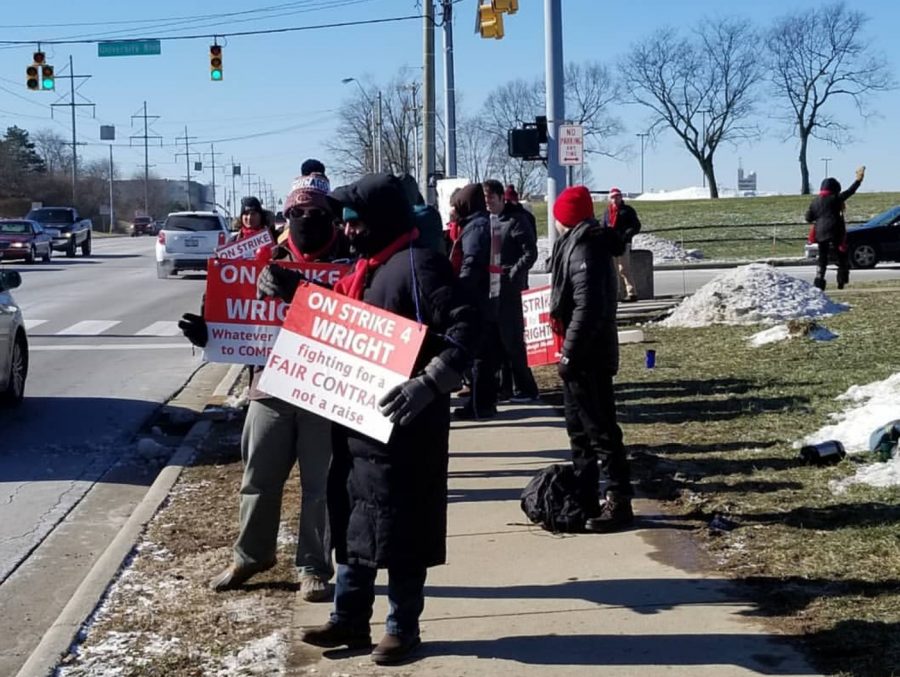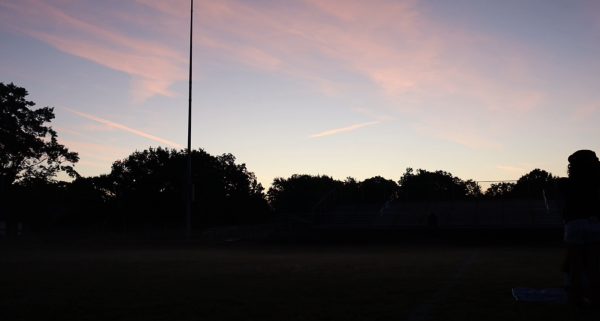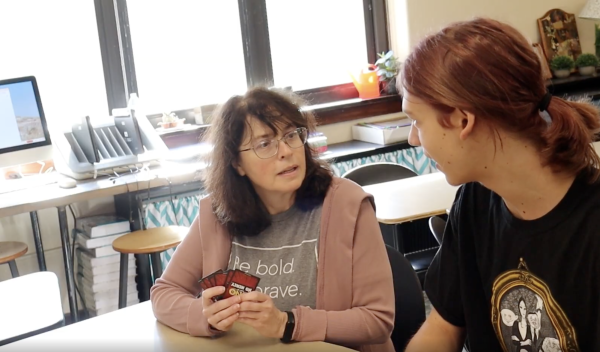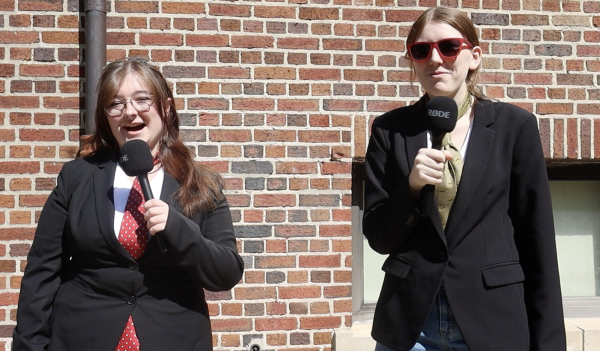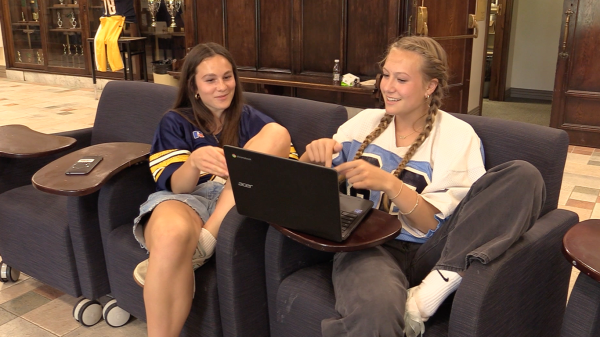Striking a deal
Wright state professors and students discuss the impact of the strike
Photo contributed by: Vaughn Shannon
Sidewalk standoff: Union members and supporters participate in picketing for the strike on the Wright State campus.
The national news spotlight has recently been focused on the teacher strikes in Los Angeles and Denver. According to theweek.com, on Jan. 14, 30,000 teachers walked off the job in Los Angeles during the district’s first strike in three decades. The strike was a result of negotiations between the district and the teacher’s union, United Teachers Los Angeles, involving class sizes, underpaid teachers, and scarce available resources. According to nytimes.com, on Tuesday, Jan. 22, teachers managed to reach a deal with officials to end the more than weeklong strike. The deal includes a series of promises to the district to be fulfilled by the fall of 2020, including a cap on possible class sizes, hiring full-time nurses for schools, as well as a librarian for every middle and high school.
Though these events may not seem to be unfolding anywhere close to home, Wright State University, a campus 14 miles away from Oakwood, experienced a major strike of their own, with many faculty and students in the middle. Union teachers opposed the administration’s proposed benefit cuts, which they say were strictly for financial stability. According to npr.org, as the strike entered its third week, there were many looming questions about the possible extensive impact on teachers, students, and the administration alike.
Dr. Geoffrey Owens is a professor of cultural anthropology and additionally serves as a member of the American Association of University Professors (AAUP), Wright State University chapter’s Executive Committee. In the simplest of terms, he was unemployed because of the strike.
“A strike involves a total withdrawal of all labor until a resolution has been agreed upon,” Owens said via email. “This withdrawal of labor includes not only teaching classes and evaluating homework but also suspending university research and participating in meetings that contribute to the day to day operations of the university.”
When the strike was ongoing and Owens was no longer teaching, he was not being paid a salary or being given health insurance by the administration. Though not present in the classroom, Owens was plenty busy helping to organize picketing on campus.
“Picketing involves having a public gathering of striking workers at the entries to Wright State University— what one usually associates with striking workers,” Owens said. “I have served as a picket captain, who organizes and brings faculty to the picket lines.”
Dr. Vaughn Shannon is an associate professor of political science at the Wright State University School of Public and International Affairs and is a dues-paying union member of the AAUP. He was an active member of the strike starting on Jan. 22 and experienced a loss of benefits because of his involvement in activities such as picketing on campus.
“It involved some cold days on the picket and social media information sharing,” Shannon said via email. “A strike is a work stoppage so there is no income for the duration of one’s time on strike, and health care and other benefits ceased immediately as well.”
Likewise, Owen’s daily schedule was radically changed throughout the entirety of the strike. Though much of his activity was focused on the strike, he continued to be in contact with his students and spent an spare time on academia.
“Faculty tries to do research, writing and other activities to the best of their ability off campus when not picketing,” Owens said.
Shannon believes there to be a number of causes behind the strike, beginning with the previous administration’s embezzlement scandal and ultimately resulting in a need for cuts in order to prevent financial collapse. Union members were supposedly protected from these cuts according to a bargain contract.
“The new administration and the WSU Board of Trustees were charged with rectifying the financial crisis, which it did with various measures including cuts to programs, salary freezes, layoffs, and increased health care premiums for staff and administration,” Shannon said. “Union faculty, who bargain contracts every three years, were shielded from much of this by the collective bargaining agreement in existence.”
As the time came for a contract renewal, negotiations took place for over two years, where mediators and outside fact-finders were included. When the administration imposed the contract in January, union members were frustrated by its content.
“The strike began as a reaction to the imposition without negotiation, and the terms within the imposed contract that many found objectionable,” Shannon said.
Owens saw the main impetus behind the strike as the attempt by the administration to remove the Union’s ability to bargain over a number of issues, including healthcare, something that brought about calls for a legal challenge.
“This elimination of the right to bargain was not only in violation of Ohio State Law, but was also an attempt to render the Faculty Union without any power,” Owens said.
The passing weeks were full of talks and decisions, with most resulting in successive stalemates. As time passed, the strike proved to reach beyond its local borders. The state government, including the State Employment Relations Board (SERB), an organization that acts as a neutral party when concerning collective bargaining laws, was heavily involved in the striking process, ruling the WSU AAUP had a right to strike in late January.
“The first week of the strike was fruitless in talks, as the administration hoped to break the strike with a ruling from the State,” Shannon said.
By the second week of the strike, negotiations were in the works between the board of trustees and administration for an agreed upon contract, but the outcome was not fruitful and failed to resolve any main issues with mutual agreement.
According to Shannon, the main issue that held back a deal was the Union’s right to negotiate concerning the available health benefits in their contract. While the administration and board of trustees wanted to maintain control, the Union wanted to retain a voice in negotiation.
“Without a deal, the board of trustees voted Feb. 3 to implement a new contract that improved several items from the January imposed contract, but also kept health care decisions at the discretion of administration from 2021 to 2023,” Shannon said.
Owens recognized that faculty was not the only group who saw their livelihoods threatened as the strike lingered. Students also potentially suffered from drawn-out arguments. The students faced pressing possibilities, such as being unable to graduate at the end of the semester and feeling as though their money was being wasted.
“In normal times, upon resolution of a strike in education, there is a side agreement to make up for any lost work, which might include working through spring break or a little bit after the end of the semester rather like when there are a lot of snow days or other emergency closings,” Owens said.
Many students on campus have been directly impacted by the strike, most heavily in the classroom, where they faced the proposition of losing the best opportunities for their education. Mark Kreutzer is a second-semester freshman at Wright State and is currently registered as a Motion Picture major, on track for a Bachelor of the Arts degree. When Kreutzer arrived at school every morning, it was hard for him to ignore the demonstrations and frustrations of faculty and fellow students.
“Every weekday morning I arrive on campus a little after 9:00, and outside the main entrance to campus off Colonel Glenn Highway, there were always a number of teachers picketing on the sidewalk,” Kreutzer said via phone. “They had quite a setup going on; tables, tents, some food, and they were out there regardless of the weather.”
According to Kreutzer, opinions about the strike were not hard to find, as it was a common and inevitably discussed topic between students in the classroom. Opinions ranged from hot air from angry students to commiseration from sympathetic ones.
The strike touched Kreutzer personally, as his political science teacher, Professor Rashida Hussain, was a participant and had to be replaced by a substitute teacher.
“Professor Hussain wasn’t super keen on commenting on the matter, she mostly told myself and the rest of my class that she was striking so we’d be aware that we’d have a substitute in that class until the strike is resolved,” Kreutzer said.
Kreutzer’s experience with the substitute, however, was not overly concerning. The class moved forward as planned.
“The impact of the strike on my learning experience was, for the most part, pretty negligible,” Kreutzer said.
The strike did not just impact Wright State faculty and students, but also managed to reach to Oakwood families, including the students of the high school, leaving many with difficult decisions to make about their livelihoods. Audrey Owens is a senior at Oakwood whose father, Dr. Owens, is an aforementioned faculty union member. When her dad was unemployed, the Owens family lost access to health care. Owens and her entire family witnessed first hand the effect such a lengthy conflict can have on daily life and practices such as going to the doctor.
“My mother’s job does not provide health care and his job had a very good health care plan before,” Owens said. “When that is taken away, it makes it harder to be able to go to things like the doctor, get a flu shot, getting a new pair of glasses, going to the dentist and getting a cavity filled.”
Faced with such pressing matters as losing their health insurance coverage, Owens and her family experienced a different dynamic at home, one that at times can be very stressful on everyone. Tensions were high, and her father ended up spending more hours on the picket lines than his normal hours teaching. As a result, he was not home as often.
According to daytondailynews.com, as of Feb. 11, the longest higher education strike in Ohio history came to an apparent end as Wright State University’s Board of Trustees voted to approve a new contract. Both sides reached a tentative agreement between negotiators for the administration and the Wright State chapter of the AAUP. The deal that is being agreed upon will last nearly five years and will extend through June 30, 2023. The contract states that the AAUP-WSU’s 500 plus members will join a university-wide health care plan. Additionally, members are slated to receive a 2.5 percent raise in 2022 and a 2.5 percent raise in 2023.
According to daytondailynews.com, in a prepared statement, President Schrader said that “Both parties made substantial concessions to help move the university forward together.”
While members of the administration pleased with the outcome, some union members, including Dr. Owens, have expressed their displeasure with recent events.
“It is worse than what we had with the previous contract,” Owens said. “However, it is much better than the contract imposed on us by the administration.”
Union members were not surprised by the outcome, as they had to make many concessions in order to reach a point of agreement with the administration.
“It was entirely made up of concessions by the Union, most of which had been offered in September of 2018,” Owens said. “The administration was forced to come to the negotiation table because the Chancellor of the Ohio Department of Education and the Governor told the administration to settle it.”
Though the Union did not receive everything they originally petitioned for, they remained in control of the right to negotiate, something that is vital to protecting their benefits in the future.
Owens said, “Most importantly, we retained the right to negotiate contracts, which is what the administration wanted to take away in the first place. This gives us hope that we can negotiate better conditions in the future.”


